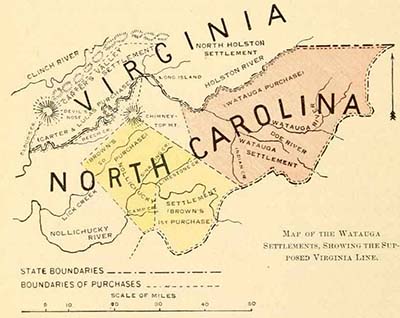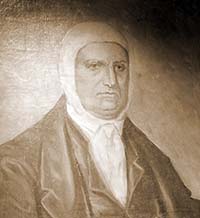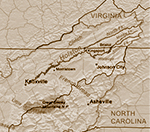 |
||||||||||||||
|
||||||||||||||
The Watauga Settlement |
||||||||||||||
|
|
||||||||||||||
|
The Watauga settlement was was south of the Holston River, on the Watauga and Nolichucky Rivers in the colony of North Carolina. There were three main settlements in the area known as Watauga, Carter's Valley, and Nolichucky. Most settlers came down the Great Valley through Virginia, while others went through gaps in the Unaka Range from North Carolina. The settlers believed they had settled in Virginia. However, all except the North Holston community were in North Carolina on land that belonged to the Cherokee Nation. They were told to relocate, but instead negotiated with the Cherokee to lease the land. Julius Dugger and Andrew Greer were the first white men to settle in the Watauga Country. They settled about three miles above the present town of Elizabethton. The first permanent settlement in Tennessee was made in 1769 on Boones Creek by Captain William Bean, and his wife Lydia. Their son, Russell Bean, is said to have been the first European child born in Tennessee. According to Samuel Masengill, Henry Massengill, Sr. settled in 1769 as one of the first settlers.
In 1771, Colonel James Robertson brought sixteen Regulator families across the mountains from North Carolina. The group included his brothers and brother-in-law. Valentine Sevier, Sr. came from the Shenandoah Valley. John Sevier settled on the Nolichucky. His sons, John and James Sevier, located on farms nearby. Jonathan Tipton and Joseph Tipton (brothers of Colonel John Tipton) had moved to the area accompanied by their father, Jonathan, who was over seventy-five years of age. Colonel John C. Carter (1737) and his son Colonel Landon C. Carter (1760) settled on the western side of the Holston River about 1770. Both John and Landon were Colonels in the American Revolution. Carter County, Tennessee was named for Landon.
Many settlers came to the Holston and Watauga Settlements after the Battle of Alamance in May, 1771, when there was a mass migration of settlers from central North Carolina to the frontier regions. These early settlers formed the Watauga Association which was was semi-autonomous government created in 1772. The first five men appointed to administer the Watauga settlement were John Sevier, James Robertson, Charles Robertson, Zachariah Isbell, and John Carter. Sinking Creek Baptist Church was organized 1772 in Washington County (now Carter County). In 1772 Jacob Brown located on the north bank of the Nolichucky River. He had brought a packhorse loaded with goods with which he purchased the lease of land from the indigenous people (and later received a deed) for a large tract on both sides of the Nolichucky. He sold this land to settlers. The government of North Carolina, however, refused to recognize the deeds' validity and continued to make grants in the territory. The John Carr family came from South Carolina, and was one of the first in Washington County, Tennessee. Fort Watauga (or Caswell) was built at the Sycamore Shoals of the Watauga River in 1775–1776 by the Watauga Association, to defend settlers from Indian (primarily Cherokee) attacks, which were in part instigated by the British. It was a group of cabins arranged in a rectangle connected by stockade walls of sharp pointed poles. On March 25, 1775 the Watauga Purchase of the East Tennessee lands from the Cherokees was made. The first settlers on Little Limestone were Robert and James Allison. In 1775 Michael Bawn and James Pearn were each granted permission by the county to build a grist-mill on Little Limestone.
After the battle with the indigenous people at Fort Watauga in 1776, a second fort was built upriver on lands owned by Valentine Sevier, Sr., but later owned by Solomon and Abraham Hart, sons of Leonard Hart. Legislative Journal of the Provincial Congress at Halifax, North Carolina Monday, December 23rd, 1776
The Johnson City area settled in 1777 by settlers who received grants from North Carolina. Among those settlers were the Young, Jones, Tipton, Jobe, Denton, and O'Neill families. The community was first known as Blue Plum. The grants were awarded in response to Great Britain's arming of Indian tribes to fight American revolutionaries. Each head of household received 640 acres and 100 acres for his wife and 100 for each child. In November, 1778
About the time of the Revolutionary War, the McCrays, the Noddings, Calverts and Bayless families migrated to Washington County. Daniel McCray and William Nodding, and both are on the 1786 list of voters and received land grants in Washington County. Jeremiah Dungan, acquired land in the area in 1778 and built a mill on Brush Creek in the present town of Watauga. "The Battle of the State of Franklin" took place at John Tipton's house in 1788. North Carolina authorities seized some of the people who John Sevier had enslaved. Sevier and his supporters came to the Tipton house to reclaim them. The North Carolinians rebuffed them and this signaled the end of the State of Franklin. Two sons of Noah Range were early settlers. Peter and Elizabeth Range settled on Knob Creek in Washington County, Tennessee, in 1779. Jacob Range improved land in 1779 on the Big Harpeth River and later petitioned for a grand to that land. In 1779, Tidence Lane established the Buffalo Ridge Baptist Church. The Jobe family was also among the early settlers. On September 25, 1780, the Overmountain Men assembled on the Sycamore Shoals of the Watauga to begin their march to the Battle of Kings Mountain. There were approximately 1,100 men. John Hendrix and Hannah Kelly moved to the Watauga settlement about 1780 In 1780 John Carter and his son, Landon C. Carter, built a two story frame home with two fireplaces. Samuel Weaver purchased 600 acres on Little Limestone creek (#629) about 1784. About 1782 members of the Broyles family moved to east Tennessee. They lived on Little Limestone Creek. Jacob Brown gave the land for the Cherokee Creek Baptist Church which was chartered in September, 1783. In late 1783, North Carolina passed an act to sell vacant land to settlers. This law, known as the Land-Grab Act, was in effect from October 20, 1783 to May 25, 1784. The entire western reserve was open to purchase by anyone who could pay 10 pounds per 100 acres. Colonel John Tipton moved to the Watagua settlement in 1783. David Matlock received a warrant for a 540-acre tract of land in Washington County in 1782 on the west side of the Doe River including the big spring and the bottom on both sides of Doe River.
In 1784, Zachariah Isbell, John Sevier and Jesse Walton were appointed to confiscate the properties of Tories in Washington County. In 1784, William Ellis purchased 325 on Boone's Creek. In August, 1784 delegates from Washington and two other western North Carolina counties (all now in Tennessee), declared their Independence from North Carolina because of perceived neglect, and misuse by North Carolina’s legislature. By May, 1785 they had petitioned to be admitted to the United States as the State of Franklin. The request was denied. John Nicholas (1753) and Margaretha Mottern were from Berks County Pennsylvania. He served in Shraedel's Company during the Revolution. On June 10, 1788 they bought 160 acres from Juliana and David Shults in Sullivan County. The John Miller-Adam Sell house was built in 1788 on Knob Creek. Mordecai Price received a patent for four hundred acres on Sinking Creek at the waters of Wattauga river on May 18, 1789. In 1790 Reverend Samuel Doak and Hezikiah Balch organized the Hebron Church in the Knob Creek settlement.
In 1791, the Treaty of Holston proclaimed a treaty with the Cherokee in Eastern Tennessee. On July 13, 1792 Moses Humphreys purchased a tract of land on the north side of Boones Creek in Washington County from William Ellis for 50 "current money." Bowlin and Mary (Lee) Curtis settled by the Watagua River about 1792.
|
|
||||||||||||
February 1, 1796 Leonard Hart obtained 239 acres next to the Hendrix Family in the Turkeytown. In 1799 the Knob Creek Brethren Chruch was established. In 1799 there was a petition in Washington County asking for marriages performed under the State of Franklin to be recognized.
|
||||||||||||||
|
|
|||||||||||||
Boones Creek Christian Church started because of a controversy over the baptism of Fanny Renfro. In 1824 Jerial Dodge baptized her at the Sinking Creek Baptist Church, and the Baptist Association decided against the baptism. James Miller and others left the church. The revival that followed on Boones Creek was called the “Great Meeting.” The revival also attracted members of the Buffalo Ridge Baptist Church. |
||||||||||||||
|
||||||||||||||
|
||||||||||||||
|
||||||||||||||
|
©Roberta Tuller 2025
|
||||||||||||||




